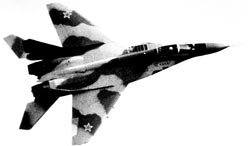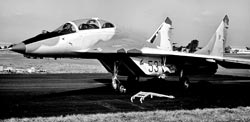
Fight now and pay later
These are among some of the significant events that go to show that Tiger guerrilla air strike capability, demonstrated with four different sorties within just over a month, has caused concerns both for the Government and in many other sectors. Last week's Situation Report which dealt with the Government's moves to acquire top of the range MiG-29 aircraft drew the attention of even President Mahinda Rajapaksa.
During a meeting with Editors and senior editorial management staff of print and electronic media, he declared, "the addition of MiG-29 fighter jets was not thought of after the LTTE attacks." He added: "It was part of the planned development of the ADS (Air Defence System), which envisaged a shift from MiG-21 (a reference to MiG-27 since the SLAF does not have and never had MiG-21) to MiG-29. This was not a sudden case of using a Mercedes Benz against a Bullock cart, as had been commented he said." See box story on this page for the statement from the President's Office. In his remarks, President Rajapaksa, who is also the Minister of Defence and Commander-in-Chief of the Armed Forces, has formally confirmed that the purchase of MiG-29s is very much on the cards though "it was not thought of after the LTTE attacks." He has said that it was part of a "planned development of the Air Defence System" and added that it was a shift from MiG-27s to MiG-29s. In other words, the plan is to phase out the MiG-27s with MiG-29s. It is not for The Sunday Times to offer advice or opinion on which type of aircraft or Air Defence systems should be procured. That is the prerogative of the Government after it obtains expert advice from the Sri Lanka Air Force and other knowledgeable quarters. However, there are aspects that have to be pointed out in the national interest since it is public funds that are used for such procurements and to prosecute the ongoing undeclared Eelam War IV. It is in this spirit that previous Air Force procurements were highlighted.
The Government, it is clear, would not make a decision to "phase out" its newly acquired MiG-27s with state-of-the-art MiG-29s without the full endorsement of the Air Force. It is they who assess the threat perceptions posed by the LTTE Air Wing and the counter measures necessary. It is they who execute the air war. Did they make such a threat assessment? Did they feel it was now necessary to "phase out" the MiG-27s that soon so MiG-29s could be acquired? What was the urgency for a hurried "phase out"? These and other questions become more relevant since the moves to acquire MiG-29s were "not thought of after the LTTE attacks." In other words, it had been decided much earlier. The question that begs answer therefore is why four MiG 27s were procured only last year at a heavy cost? This is particularly if there were plans to "phase out" the MiG-27s with MiG-29s only months later. Delivery of these MiG-27s took place only in December, last year. They have been barely used for five months. As revealed last week, two of them became non operational but one has been repaired. The other awaits the arrival of spares under the warranty. The Sunday Times of December 3, 2006 declared in a front page report that the purchases of four MiG-27 ground attack aircraft and overhaul to seven others now with the Air Force have raised a number of questions. The report revealed that four MiG-27 aircraft were purchased for US$ 2,462,000 (or Rs 265,896,000) each. Thus, the four MiG-27s cost US$ 9,848,000 or Rs 1,063, 584,000. That is one billion, sixty three million five hundred and eighty four thousand rupees. This deal was put through by Sri Lanka's Ambassador to Russia, Udayanga Weeratunga. The Sunday Times reliably learns that the Air Force wants to procure four new MiG-29SM multi role combat aircraft. This model has the ability, among others, to carry guided air-to-surface missiles, TV and laser guided bombs. This is on a pre-arranged credit from Russia lasting anything between seven and ten years. Thus, it would be a successive Government that would meet the payment obligations if the deal goes through. Though the final price is yet to be determined, the negotiations are taking place in Colombo. The average price of a MiG-29SM is said to be US$ 15 million (or Rs 1,665 million) each. In addition, the Air Force also wants to acquire a new MiG-29UB trainer at the same price, a spares package, an UAV system, brand new helicopters, overhaul and upgrade existing helicopters. The total cost of the entire deal, Air Force sources say, is estimated at US$ 145 million (or Rs 16,095,000 million). That is without the cost for missiles for the MiG-29s. That is sixteen billion and ninety five million rupees. The Government proposes to conclude the deal through the state-owned company Lanka Logistics and Technologies Limited. It is headed by Defence Secretary Gotabhaya Rajapaksa. Thus, the total cost for the MiG-27s procured last year (Rs 1,063,584,000) and the estimated (Rs 16,095,000,000), all for Air Defence related costs brings the total to a Rs 171,183,844,800. In other words, it is staggering over Rs 17.1 billion (Rs 17,158,584,000). The MiG-29 multi role combat aircraft, identified as Fulcrum by the NATO (North Atlantic Treaty Organisation), is Russia's answer to western combat aircraft. According to Wikipedia internet encyclopedia, the history of MiG-29 started in 1969 when the then Soviet Union learned of the US Air Force's 'FX' programme, which resulted in the F-15 Eagle. The Soviet leadership soon realized that the new American fighter would represent a serious technological advantage over all existing Soviet fighters. The MiG 21 'Fishbed" was agile by the standards of its day, but had deficiencies in range, armament and growth potential. The MiG-23 (NATO name Flogger), developed to match the F-4 Phantom II, was fast and had more space for fuel and equipment, but lacked in maneuverability and dog fighting ability. What was needed was a better-balanced fighter with both good agility and sophisticated systems. In response, the Soviet General Staff issued a requirement for a "Advanced Frontline Fighter". Specifications were extremely ambitious, calling for long range, good short-field performance (including the ability to use austere runways), excellent agility, Mach 2 plus speed and heavy armament. Thus the MiG-29 was born. Thus it is quite clear that the MiG-29 was the result of the battle for air supremacy by two most powerful world powers then. The question is whether any flying or non flying wizard is trying to equate a non state actor like the LTTE, with only some light aircraft and make out that they would acquire advanced combat aircraft? At present, the LTTE is known to have only the Czech-built Zlin Z-143 light aircraft. This explains the comparison in last week's Situation Report. It is like buying a brand new Mercedes Benz to knock down a bullock cart. As things stand today, there is no information from any intelligence agency, either local or foreign, that the LTTE is in possession of highly advanced fighter jets. It only has a fleet of light aircraft, known to be ten. Hence, did whoever promoting the MiG-29 package deal think well ahead of any future LTTE acquisitions? Do they sincerely believe that the LTTE will in future acquire fighter jets used by conventional air forces of sovereign governments? The answers will never be known for there is no transparency in military procurements amounting to millions or billions of rupees. Here again it must be emphasized that the costs for missiles, be it heat seeking, radar or laser guided are in addition to purchase costs of the MiG-29 fighters. One of the missiles being considered for purchase is the medium range infra red guided air-to-air missile. Despite veiled personal threats and insidious attempts at intimidation directed at me, it must be said in the public interest that the ongoing undeclared Eelam War IV has become the costliest phase of all separatist wars. The reasons are many and none of them can be detailed out. Suffice to say they include a lack of any transparency and the absence of proper, careful assessment of urgent military needs. This indeed has been a malaise that has accompanied successive phases of the separatist war. The recent procurement of MiG-27s and the intended purchase of MiG-29s clearly illustrate the case. These developments are taking place at a time when the economy is taking a bad turn, the rupee equivalent to the dollar is deteriorating and the people who sustain the war effort are forced to pay more and more for their daily livelihood. Last week I pointed out that four different air raids within just over a month have caused more panic and concern in the country's defence establishment than four different phases of the separatist war - the last being the ongoing undeclared Eelam War IV. To illustrate how the cost of war has been rising, I quoted some figures. Errors have crept into some of the prices mentioned in US dollars and their equivalents in Sri Lankan rupees. I repeat the paragraphs in question with the correct amounts: "In addition, a 14.5 mm twin barrel ammunition for type 82 gun used by the Navy costs US $28,080 (or Rs 3,116,880) each. In most instances, procurement of military items will have to be after cash is paid upfront. One leading supplier to Sri Lanka backed out from selling military hardware until such time outstanding dues, said to exceed over US $ 200 million (over Rs. 22 billion) is settled. This has forced the Government to turn to another agency in the same country." It is therefore very clear that not only living costs that are on the rise. The cost of the ongoing undeclared Eelam War IV, for which the public will be compelled to pay more, is rising equally faster. This is despite the new policy of fight now with foreign equipment and pay later - a burden that will fall on the next Government, whichever that may be.
|
|| Front
Page | News | Editorial | Columns | Sports | Plus | Financial
Times | International | Mirror | TV
Times | Funday
Times || |
| |
Copyright
2007 Wijeya
Newspapers Ltd.Colombo. Sri Lanka. |


 The President's office on Wednesday issued the following official statement:
The President's office on Wednesday issued the following official statement: